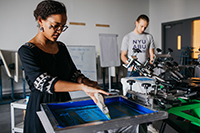As a student intern at NYU Abu Dhabi, Lolowa AlKindi was introduced to the CubeSat project. With a small team of students and researchers, AlKindi analyzed data gathered from satellites and learned to conduct scientific research as part of her internship. Seeing the Emirati’s passion and potential in space science, AlKindi joined the NYUAD Kawader program — a national capacity-building research fellowship program that allows outstanding graduates to gain experience in a cutting-edge academic research environment.
After graduating from Sorbonne University Abu Dhabi, AlKindi enrolled in the Kawader program and officially became a member of the Light-1 CubeSat Team. “I am very thankful for the professors who recognized my potential and allowed me to become part of this amazing project,” AlKindi said.
As a research assistant, AlKindi’s main role is building a detector to test and analyze Terrestrial gamma-ray Flashes (TGFs) collected from the satellite. TGFs are gamma-rays that come from Earth associated with thunderstorms and lightning activities. A deeper understanding of TGFs and its radiation impact will allow researchers to mitigate potential dangers and impact on aircraft electronics, keeping aircrafts and its passengers safe mid-flight.
During her first year, the bulk of AlKindi’s time was testing detector samples to ensure the components are space-qualified to become part of the payload of the Light-1 Cubesat. That same year, collaborating with Khalifa University (KU), the project won the UAE Space Agency’s MiniSat Competition which provided them with the funds they needed to launch the CubeSat into space. The NYUAD team worked on building the detector while the team from KU worked on building a system that will hold this detector. AlKindi was the main liaison between the two universities and the UAE Space Agency – ensuring a smooth line of communication on each team’s progress.
When Pandemic Struck
It turned out the greatest challenge of the project wasn’t the intricacy of building a spacebound satellite. It was the limited access to the labs due to safety restrictions in place to keep the community safe from the pandemic. With much testing yet to be done, the project’s slow progress resulted in the decision to postpone its launch date.
With a SpaceX rocket successfully launched into space late last year, the CubeSat had spent a few weeks on the International Space Station (ISS) before finally being deployed into orbit in February.
With the CubeSat now collecting information, AlKindi is working with the data analysis team to decode and study the TGF data coming from the Light-1 CubeSat and understand how TGFs are produced by lightning.
Kawader Program
Being involved in the Light-1 CubeSat project has given AlKindi a clear sense of how space missions are planned and executed. “Through the Kawader program, I was able to work with a fantastic team, travel and learn from (others), and build a good network with people in the space industry. All of which are important when it comes to starting my career,” Al Kindi said.
Looking forward, AlKindi would love to continue her studies in science and explore the options available when it comes to space science here in the UAE. “There is so much I haven’t tried yet and I want to get to know all the options before I move forward with my career.”


